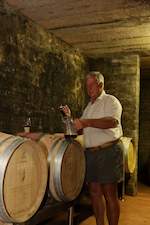Jan began the transformation of Kanonkop into a Cape great in 1969. He uprooted the predominantly Shiraz vines, seeing the future in Cabernet Sauvignon, the possibilities of a Bordeaux-style red blend, and the potential in Pinotage.

He bottled Kanonkop's first reds, a Cabernet Sauvignon and Pinotage, in 1973; planted the first Pinot Noir in 1976; and laid the groundwork for the famous Paul Sauer red blend in 1979. A year after buying property in Paradyskloof at the foot of Stellenbosch Mountain, Jan, with typically dogged determination, took his young family to Burgundy for six months, based at the famous wine house, Joseph Drouhin.
Two years before, a Springbok rugby tour to France had been cancelled due to sanctions against South Africa and Jan had sworn that 'if I couldn't go to France as a rugby player, I'd go as a winemaker'.
Back home he planted Vriesenhof to the reds of Bordeaux - Cabernet Sauvignon, Cabernet Franc and Merlot - and the two Burgundian classics - Pinot Noir and Chardonnay. They formed the backbone of the Vriesenhof range, led by the Bordeaux-style blend Kallista. Pinotage followed, becoming part of the 'second label' Paradyskloof before graduating to the premium range.
Whereas Jan's Kanonkop wines were heavyweights, his Vriesenhof style is more elegant. The original 15 hectares of vines in the early 1980s has increased to 45 hectares of the 60-hectare landholding. The latest addition to his line-up is a single-varietal Grenache grown up in the Piekenierskloof near Citrusdal. Another Grenache from Stellenosch will follow soon.
He has experimented widely, particularly with his beloved Pinot Noir, not commonly grown in Stellenbosch. He has matched a variety of Burgundian red wine clones (as opposed to the Swiss sparkling wine clone used by his peers in the early days) to different soils, microclimates and barrels, bottling different expressions of the same variety separately, building up a bank of knowledge on the interplay between all these influences.
Which is how he’s discovered first-hand, for example, that Pinot Noir made from fruit grown on shale soil is too acidic for one of his favourite dishes: coq au vin. He prefers the Pinot from clone PN115 planted on granite or sandstone soils: 'It's softer.'
His priorities and passions show in the development of Vriesenhof. The vineyards came first. Then came the winery. A modern fermentation cellar was built. An underground maturation cellar was renovated beneath the farmhouse à la Burgundy - a steep wooden stairway off the kitchen gives quick access. Its maze of cool, cobwebbed rooms holds barrels of wine and Jan's vast, eclectic collection of bottled wines.
The workers' cottages came next. Jan was a driving force in the Rural Foundation, which is devoted to uplifting disadvantaged local communities, including impoverished indentured farm workers, and agitating for their freehold property rights.
 Cape Coq au Vin Recipe with Vriesenhof Pinot Noir by Jan ‘Boland’ Coetzee....
Cape Coq au Vin Recipe with Vriesenhof Pinot Noir by Jan ‘Boland’ Coetzee.... Delicious pumpkin pie recipe paired with Vriesenhof Pinotage by Jan ‘Boland’ Coetzee....
Delicious pumpkin pie recipe paired with Vriesenhof Pinotage by Jan ‘Boland’ Coetzee....